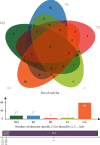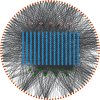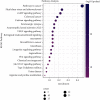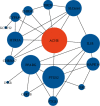Network Pharmacology-Based Study of the Underlying Mechanisms of Huangqi Sijunzi Decoction for Alzheimer's Disease
- PMID: 34650613
- PMCID: PMC8510793
- DOI: 10.1155/2021/6480381
Network Pharmacology-Based Study of the Underlying Mechanisms of Huangqi Sijunzi Decoction for Alzheimer's Disease
Abstract
Background: Huangqi Sijunzi decoction (HQSJZD) is a commonly used conventional Chinese herbal medicine prescription for invigorating Qi, tonifying Yang, and removing dampness. Modern pharmacology and clinical applications of HQSJZD have shown that it has a certain curative effect on Alzheimer's disease (AD).
Methods: The active components and targets of HQSJZD were searched in the Traditional Chinese Medicine Systems Pharmacology Database and Analysis Platform (TCMSP). The genes corresponding to the targets were retrieved using UniProt and GeneCard database. The herb-compound-target network and protein-protein interaction (PPI) network were constructed by Cytoscape. The core targets of HQSJZD were analysed by Gene Ontology (GO) and Kyoto Encyclopedia of Genes and Genomes (KEGG). The main active compounds of HQSJZD were docked with acetylcholinesterase (AChE). In vitro experiments were conducted to detect the inhibitory and neuroprotective effects of AChE.
Results: Compound-target network mainly contained 132 compounds and 255 corresponding targets. The main compounds contained quercetin, kaempferol, formononetin, isorhamnetin, hederagenin, and calycosin. Key targets contained AChE, PTGS2, PPARG, IL-1B, GSK3B, etc. There were 1708 GO items in GO enrichment analysis and 310 signalling pathways in KEGG, mainly including the cAMP signalling pathway, the vascular endothelial growth factor (VEGF) signalling pathway, serotonergic synapses, the calcium signalling pathway, type II diabetes mellitus, arginine and proline metabolism, and the longevity regulating pathway. Molecular docking showed that hederagenin and formononetin were the top 2 compounds of HQSJZD, which had a high affinity with AChE. And formononetin has a good neuroprotective effect, which can improve the oxidative damage of nerve cells.
Conclusion: HQSJZD was found to have the potential to treat AD by targeting multiple AD-related targets. Formononetin and hederagenin in HQSJZD may regulate multiple signalling pathways through AChE, which might play a therapeutic role in AD.
Copyright © 2021 Wei Zhang et al.
Conflict of interest statement
The authors declare no conflicts of interest.
Figures









Similar articles
-
[Huangqi Sijunzi decoction for treating cancer-related fatigue in breast cancer patients: a randomized trial and network pharmacology study].Nan Fang Yi Ke Da Xue Xue Bao. 2022 May 20;42(5):649-657. doi: 10.12122/j.issn.1673-4254.2022.05.04. Nan Fang Yi Ke Da Xue Xue Bao. 2022. PMID: 35673907 Free PMC article. Clinical Trial. Chinese.
-
Network Pharmacology Analysis on the Mechanism of Huangqi Sijunzi Decoction in Treating Cancer-Related Fatigue.J Healthc Eng. 2021 Nov 18;2021:9780677. doi: 10.1155/2021/9780677. eCollection 2021. J Healthc Eng. 2021. Retraction in: J Healthc Eng. 2023 Oct 11;2023:9895186. doi: 10.1155/2023/9895186. PMID: 35154614 Free PMC article. Retracted.
-
Network pharmacology to unveil the mechanism of suanzaoren decoction in the treatment of alzheimer's with diabetes.Hereditas. 2024 Jan 3;161(1):2. doi: 10.1186/s41065-023-00301-z. Hereditas. 2024. PMID: 38167125 Free PMC article.
-
[Mechanism and experimental verification of Sijunzi Decoction in treatment of ulcerative colitis based on network pharmacology].Zhongguo Zhong Yao Za Zhi. 2020 Nov;45(22):5362-5372. doi: 10.19540/j.cnki.cjcmm.20200810.405. Zhongguo Zhong Yao Za Zhi. 2020. PMID: 33350195 Chinese.
-
Exploration of the mechanism of Zisheng Shenqi decoction against gout arthritis using network pharmacology.Comput Biol Chem. 2021 Feb;90:107358. doi: 10.1016/j.compbiolchem.2020.107358. Epub 2020 Aug 8. Comput Biol Chem. 2021. PMID: 33243703 Review.
Cited by
-
Integrated network pharmacology and metabolomics to reveal the mechanism of Pinellia ternata inhibiting non-small cell lung cancer cells.BMC Complement Med Ther. 2024 Jul 11;24(1):263. doi: 10.1186/s12906-024-04574-3. BMC Complement Med Ther. 2024. PMID: 38992647 Free PMC article.
-
An updated review of the pharmacological effects and potential mechanisms of hederagenin and its derivatives.Front Pharmacol. 2024 Jun 19;15:1374264. doi: 10.3389/fphar.2024.1374264. eCollection 2024. Front Pharmacol. 2024. PMID: 38962311 Free PMC article. Review.
-
A Network Pharmacology Method Combined with Molecular Docking Verification to Explore the Therapeutic Mechanisms Underlying Simiao Pill Herbal Medicine against Hyperuricemia.Biomed Res Int. 2023 Feb 9;2023:2507683. doi: 10.1155/2023/2507683. eCollection 2023. Biomed Res Int. 2023. Retraction in: Biomed Res Int. 2024 Jan 9;2024:9754274. doi: 10.1155/2024/9754274. PMID: 36817858 Free PMC article. Retracted.
-
Pharmacological effects of herbal ingredients of Manasamitra vatakam in the treatment of Alzheimer's disease: A review.J Ayurveda Integr Med. 2025 Jan-Feb;16(1):101041. doi: 10.1016/j.jaim.2024.101041. Epub 2025 Jan 11. J Ayurveda Integr Med. 2025. PMID: 39799838 Free PMC article. Review.
-
Radix Astragali and Its Representative Extracts for Diabetic Nephropathy: Efficacy and Molecular Mechanism.J Diabetes Res. 2024 Sep 14;2024:5216113. doi: 10.1155/2024/5216113. eCollection 2024. J Diabetes Res. 2024. PMID: 39308629 Free PMC article. Review.
References
-
- Australia D., Baker S., Banerjee S. World Alzheimer Report 2019: Attitudes to Dementia . London, UK: Alzheimer’s Disease International; 2019.
LinkOut - more resources
Full Text Sources
Research Materials
Miscellaneous

